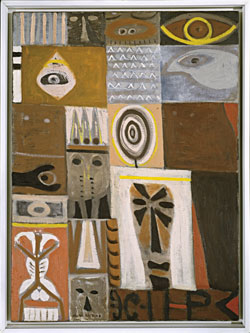1.2
Middle Years Activity
Signs and Symbols: A Compositional Task

Adolph GOTTLIEB
American 1903–74
Augury 1945
oil on canvas
101.6 x 76.1 cm
Solomon R. Guggenheim Museum, New York
Gift, Sylvia and Joseph Slifka
© Adolph Gottlieb/VAGA, New York. Licensed by VISCOPY Australia
48.1172.516
For |
Middle Years Students |
Curriculum |
Visual Arts – Creating and Making |
Think About |
“art is an adventure into an unknown world, which can be explored by those willing to take risks.” |
Aim |
To gain insight to the influence of tribal art and symbols through a focus on the art work Adolf Gottlieb. |
Preparation |
To do this activity you will need to:
|
Individual Task |
Collect signs, symbols and images. Explain how you think these symbols capture the essence of these belief systems. |
Group Task |
Use this experimentation as the basis for a whole class activity/mural, where each student contributes one or two symbols towards the overall design. Possible materials:
|
Discussion Questions |
Discuss your response to this work with others. |